
Armour or armor is a covering used to protect an object, individual, or vehicle from physical injury or damage, especially direct contact weapons or projectiles during combat, or from a potentially dangerous environment or activity. Personal armour is used to protect soldiers and war animals. Vehicle armour is used on warships, armoured fighting vehicles, and some mostly ground attack combat aircraft.

Hoplites were citizen-soldiers of Ancient Greek city-states who were primarily armed with spears and shields. Hoplite soldiers used the phalanx formation to be effective in war with fewer soldiers. The formation discouraged the soldiers from acting alone, for this would compromise the formation and minimize its strengths. The hoplites were primarily represented by free citizens – propertied farmers and artisans – who were able to afford a linen armour or a bronze armour suit and weapons. Most hoplites were not professional soldiers and often lacked sufficient military training. Some states maintained a small elite professional unit, known as the epilektoi ("chosen") since they were picked from the regular citizen infantry. These existed at times in Athens, Argos, Thebes, and Syracuse, among others. Hoplite soldiers made up the bulk of ancient Greek armies.
A spear is a pole weapon consisting of a shaft, usually of wood, with a pointed head. The head may be simply the sharpened end of the shaft itself, as is the case with fire hardened spears, or it may be made of a more durable material fastened to the shaft, such as bone, flint, obsidian, iron, steel, or bronze. The most common design for hunting or combat spears since ancient times has incorporated a metal spearhead shaped like a triangle, lozenge, or leaf. The heads of fishing spears usually feature barbs or serrated edges.

A shield is a piece of personal armour held in the hand, which may or may not be strapped to the wrist or forearm. Shields are used to intercept specific attacks, whether from close-ranged weaponry or projectiles such as arrows, by means of active blocks, as well as to provide passive protection by closing one or more lines of engagement during combat.
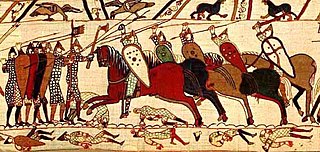
A lance is a spear designed to be used by a mounted warrior or cavalry soldier (lancer). In ancient and medieval warfare, it evolved into the leading weapon in cavalry charges, and was unsuited for throwing or for repeated thrusting, unlike similar weapons of the javelin and pike family typically used by infantry. Lances were often equipped with a vamplate, a small circular plate to prevent the hand sliding up the shaft upon impact, and beginning in the late 14th century were used in conjunction with a lance rest attached to the breastplate. Though best known as a military and sporting weapon carried by European knights and men-at-arms, the use of lances was widespread throughout Asia, the Middle East, and North Africa wherever suitable mounts were available. Lancers of the medieval period also carried secondary weapons such as swords, battle axes, war hammers, maces and daggers for use in hand-to-hand combat, since the lance was often a one-use-per-engagement weapon; assuming the lance survived the initial impact without breaking, it was often too long, heavy, and slow to be effective against opponents in a melee.
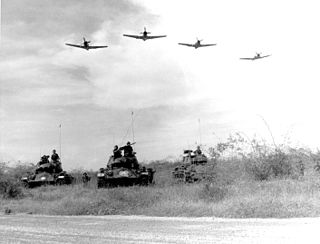
Combined arms is an approach to warfare that seeks to integrate different combat arms of a military to achieve mutually complementary effects. According to the strategist William S. Lind, combined arms can be distinguished from the concept of "supporting arms" as follows:
Combined arms hits the enemy with two or more arms simultaneously in such a manner that the actions he must take to defend himself from one make him more vulnerable to another. In contrast, supporting arms is hitting the enemy with two or more arms in sequence, or if simultaneously, then in such combination that the actions the enemy must take to defend himself from one also defends himself from the other(s).

A man-at-arms was a soldier of the High Medieval to Renaissance periods who was typically well-versed in the use of arms and served as a fully-armoured heavy cavalryman. A man-at-arms could be a knight, or other nobleman, a member of a knight's or nobleman's retinue, or a mercenary in a company serving under a captain. Such men could serve for pay or through a feudal obligation. The terms knight and man-at-arms are often used interchangeably, but while all knights equipped for war were men-at-arms, not all men-at-arms were knights.
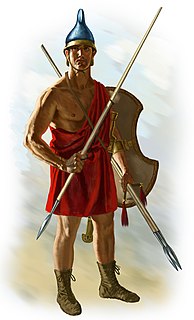
A peltast was a type of light infantryman, originating in Thrace and Paeonia, and named after the kind of shield he carried. Thucydides mentions the Thracian peltasts, while Xenophon in the Anabasis distinguishes the Thracian and Greek peltast troops. The peltast often served as a skirmisher in Hellenic and Hellenistic armies. In the Medieval period, the same term was used for a type of Byzantine infantryman.

Light cavalry comprised lightly armed and armored cavalry troops mounted on fast horses, as opposed to heavy cavalry, where the mounted riders were heavily armored. The purpose of light cavalry was primarily raiding, reconnaissance, screening, skirmishing, patrolling and tactical communications. Prior to the early 17th century they were usually armed with swords, spears, javelins, or bows, and later on with sabres, pistols, shotguns, or carbines.

Chinese armour was predominantly lamellar from the Warring States period onward, prior to which animal parts such as rhinoceros hide, rawhide, and turtle shells were used for protection. Lamellar armour was supplemented by scale armour since the Warring States period or earlier. Partial plate armour was popular from the Northern and Southern dynasties (420–589), and mail and mountain pattern armour from the Tang dynasty (618–907). Chain mail had been known since the Han Dynasty, but did not see widespread production or battlefield use, and may have seen as "exotic foreign armor" used as a display of wealth for wealthier officers and soldiers. During the Ming dynasty (1368–1644), brigandine began to supplant lamellar armour and was used to a great degree into the Qing dynasty (1644–1912). By the 19th century most Qing armour, which was of the brigandine type, were purely ceremonial, having kept the outer studs for aesthetic purposes, and omitted the protective metal plates.
A kite shield is a large, almond-shaped shield rounded at the top and curving down to a point or rounded point at the bottom. The term "kite shield" is a reference to the shield's unique shape, and is derived from its supposed similarity to a flying kite, although "leaf-shaped shield" and "almond shield" have also been used in recent literature. Since the most prominent examples of this shield have appeared on the Bayeux Tapestry, the kite shield has become closely associated with Norman warfare.
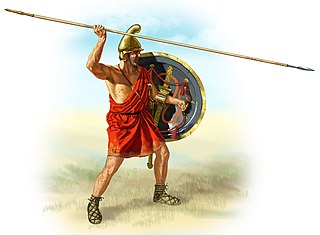
The army of the Kingdom of Macedon was among the greatest military forces of the ancient world. It was created and made formidable by King Philip II of Macedon; previously the army of Macedon had been of little account in the politics of the Greek world, and Macedonia had been regarded as a second-rate power.
The Sasanian army was the primary military body of the Sasanian armed forces, serving alongside the Sasanian navy. The birth of the army dates back to the rise of Ardashir I, the founder of the Sasanian Empire, to the throne. Ardashir aimed at the revival of the Persian Empire, and to further this aim, he reformed the military by forming a standing army which was under his personal command and whose officers were separate from satraps, local princes and nobility. He restored the Achaemenid military organizations, retained the Parthian cavalry model, and employed new types of armour and siege warfare techniques. This was the beginning for a military system which served him and his successors for over 400 years, during which the Sasanian Empire was, along with the Roman Empire and later the East Roman Empire, one of the two superpowers of Late Antiquity in Western Eurasia. The Sasanian army protected Eranshahr from the East against the incursions of central Asiatic nomads like the Hephthalites and Turks, while in the west it was engaged in a recurrent struggle against the Roman Empire.

Roman military personal equipment was produced in small numbers to established patterns, and used in an established manner. These standard patterns and uses were called the res militaris or disciplina. Its regular practice during the Roman Republic and Roman Empire led to military excellence and victory. The equipment gave the Romans a very distinct advantage over their barbarian enemies, especially so in the case of armour. This does not mean that every Roman soldier had better equipment than the richer men among his opponents. According to Edward Luttwak, Roman equipment was not of a better quality than that used by the majority of Rome's adversaries. Other historians and writers have stated that the Roman army's need for large quantities of "mass produced" equipment after the Marian Reforms and subsequent civil wars led to a decline in the quality of Roman equipment compared to the earlier Republican era:
The production of these kinds of helmets of Italic tradition decreased in quality because of the demands of equipping huge armies, especially during civil wars...The bad quality of these helmets is recorded by the sources describing how sometimes they were covered by wicker protections, like those of Pompeius' soldiers during the siege of Dyrrachium in 48 BC, which were seriously damaged by the missiles of Caesar's slingers and archers.
It would appear that armour quality suffered at times when mass production methods were being used to meet the increased demand ..." and "...the reduced size curiasses would also have been quicker and cheaper to produce, which may have been a deciding factor at times of financial crisis, or where large bodies of men were required to be mobilized at short notice, possibly reflected in the poor-quality, mass produced iron helmets of Imperial Italic type C, as found, for example, in the River Po at Cremona, associated with the Civil Wars of AD 69 AD; Russel-Robinson, 1975, 67
Up until then, the quality of helmets had been fairly consistent and the bowls well decorated and finished. However, after the Marian Reforms, with their resultant influx of the poorest citizens into the army, there must inevitably have been a massive demand for cheaper equipment, a situation which can only have been exacerbated by the Civil Wars...
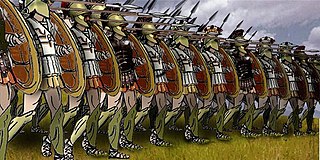
Heavy infantry consisted of heavily armed and armoured infantrymen who were trained to mount frontal assaults and/or anchor the defensive center of a battle line. This differentiated them from light infantry who are relatively mobile and lightly armoured skirmisher troops intended for screening, scouting, and other tactical roles unsuited to soldiers carrying heavier loads. Heavy infantry typically made use of dense battlefield formations, such as shield wall or phalanx, multiplying their effective weight of arms with force concentration.
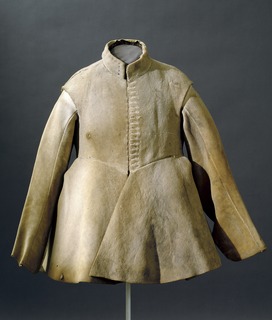
The European buff coat is an item of leather clothing that was primarily worn by cavalry and officers during the 17th century, but also worn by a small number of infantry. It was often worn under iron or steel armour for the torso. The buff coat was derived from the simple leather jerkins employed by huntsmen and soldiers during the Tudor period, these in turn deriving from the arming doublet. The name of the jacket, as well as its characteristic tan or buff colour, derives from the buffalo or ox hide from which it was commonly made.

A coat of plates is a form of segmented torso armour consisting of overlapping metal plates riveted inside a cloth or leather garment. The coat of plates is considered part of the era of transitional armour and was normally worn as part of a full knightly harness. The coat saw its introduction in Europe among the warring elite in the 1180s or 1220s and was well established by the 1250s. It was in very common usage by the 1290s. By the 1350s it was universal among infantry militias as well. After about 1340, the plates covering the chest were combined to form an early breastplate, replacing the coat of plates. After 1370, the breastplate covered the entire torso. Different forms of the coat of plates, known as the brigandine and jack of plates, remained in use until the late 16th century.
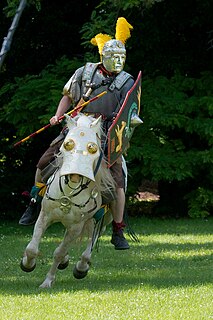
The hippika gymnasia were ritual tournaments performed by the cavalry of the Roman Empire to both practice their skills and display their expertise. They took place on a parade ground situated outside a fort and involved the cavalry practicing manoeuvring and the handling of weapons such as javelins and spears. The riders and their mounts wore highly elaborate armour and helmets specially made for display purposes, decorated with images from classical mythology. Such tournaments served several purposes, improving the riders' skills, helping to build unit morale and impressing dignitaries and conquered peoples.
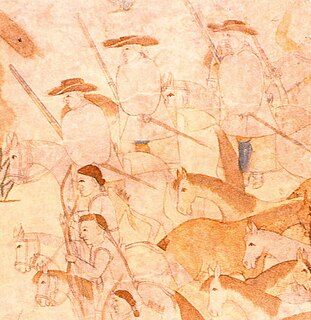
The soldados de cuera served in the frontier garrisons of northern New Spain, the Presidios, from the late 16th to the early 19th century. They were mounted and were an exclusive corps in the Spanish Empire. They took their name from the multi-layered deer-skin cloak they wore as protection against Indian arrows. When New Spain's visitador José de Gálvez organized the Portola Expedition, he was accompanied by a party of 25 soldiers, the "finest horsemen in the world, and among these soldiers who best earn their bread from the august monarch whom they serve".

Mughal weapons significantly evolved during the ruling periods of its various rulers. During its conquests throughout the centuries, the military of the Mughal Empire used a variety of weapons including swords, bows and arrows, horses, camels, elephants, some of the world's largest cannons, muskets and flintlock blunderbusses.

















